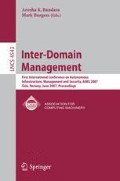Abstract
Over the past years, much effort has been devoted to investigate the interplay of peer-to-peer protocols and the underlying network infrastructure. One surprising result of these studies is the insight that peer-to-peer mechanisms can be pushed down into the network layer. The probably most thoroughly researched embodiment of that idea is the Scalable Source Routing (SSR) protocol. Recently, another similar protocol has been published, the Virtual Ring Routing (VRR) protocol. This tutorial explains both protocols and discusses their potential uses in large self-organizing networks.
SSR and VRR are self-organizing routing protocols which have been inspired by structured peer-to-peer routing protocols such as Chord. Unlike Chord, SSR and VRR are genuine network layer protocols. They are especially suited for networks that do not have a well crafted structure, for example, sensor-actuator networks, ad-hoc networks and mesh networks. In particular, SSR is very memory efficient so that it can provide routing among nodes with very limited resources. This resource efficiency might also prove beneficial for large meshes of multi-homed wireline networks because it greatly reduces the size of the routers’ forwarding information base.
Both, SSR and VRR work on a flat identifier space. As a consequence, they can easily support host mobility without requiring any location directory or other centralized service. Furthermore, SSR and VRR directly provide key based routing in the network layer so that they can serve as efficient basis for fully decentralized applications. Both protocols are based on a virtual ring structure which is used in a Chord-like manner. SSR builds source routes to previously unknown destinations and caches them at so-called intermediate nodes. VRR creates state along the respective paths.
This tutorial gives an in-depth introduction to SSR and VRR. It relates the protocols to previous approaches in ad-hoc networks, mesh networks and sensor networks; and it discusses the various parameters that optimize the protocols in a given scenario. The tutorial concludes with three practical examples from the presenter’s research group. As a result, the participants will be well prepared to apply SSR or VRR for their own purposes.
Access this chapter
Tax calculation will be finalised at checkout
Purchases are for personal use only
Author information
Authors and Affiliations
Editor information
Rights and permissions
Copyright information
© 2007 Springer-Verlag Berlin Heidelberg
About this paper
Cite this paper
Fuhrmann, T. (2007). Scalable Routing for Large Self-organizing Networks. In: Bandara, A.K., Burgess, M. (eds) Inter-Domain Management. AIMS 2007. Lecture Notes in Computer Science, vol 4543. Springer, Berlin, Heidelberg. https://doi.org/10.1007/978-3-540-72986-0_37
Download citation
DOI: https://doi.org/10.1007/978-3-540-72986-0_37
Publisher Name: Springer, Berlin, Heidelberg
Print ISBN: 978-3-540-72985-3
Online ISBN: 978-3-540-72986-0
eBook Packages: Computer ScienceComputer Science (R0)

